A few babies are starting to learn the ropes, out on our feeders:
For the first time, I saw young downy woodpeckers following their parents to the suet and peanuts. The reason I noticed they were young was because they were begging and flapping.
Didn't get a photo.
But I did get one of a juvenile house finch, sampling the grapes:
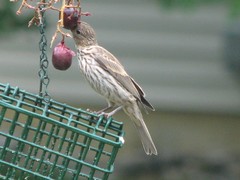
(I know it's a juvenile by the extra bold streaking, different from the adult females)
Someone clear this up for me. This guy was at the feeders today, and while he has the "downy" coloring all over his body, his head has a whole lot of red on the top instead of the nape. It looks like a yellow-bellied sapsucker head on a downy body. Anyone want to chime in? The belly was all white, like a downy.
Here's something you don't see everyday.
One of our guppies born last year was a conjoined twin. I assume two eggs stuck together, and one developed and one didn't. This one was a male, and he had an eye and dorsal fin growing from his abdomen. Well, he died yesterday, and I took the opportunity to finally get a good picture of him. I guess the "twin" grew up into his belly so much that it inhibited digestion or respiration.
Rest in peace, little mutant.
One of our guppies born last year was a conjoined twin. I assume two eggs stuck together, and one developed and one didn't. This one was a male, and he had an eye and dorsal fin growing from his abdomen. Well, he died yesterday, and I took the opportunity to finally get a good picture of him. I guess the "twin" grew up into his belly so much that it inhibited digestion or respiration.
Rest in peace, little mutant.
And now, a study of Cooper's hawks:
Our darling Mary posted a picture of a hawk she wasn't sure of, and I made a vow to keep her from "giving up" on raptors. I know how she feels...when I first became a birder, sparrows and raptors were a mystery. They are all differing shades of brown, and my untrained eyes glazed over whenever I saw one. Now, the sparrows are still tough sometimes (as they are to many) but I think I have a fairly good grasp on birds of prey. I better, since I am teaching the next generation about them.
(And this is for anyone who reads my blog and wants to know more about IDs. Most of my regulars don't need this, but hey.)
I've posted these before, but I don't have any new ones yet this year.
As soon as you see a bird of prey, immediately look for three things:
1. Head
2. Tail
3. Belly
99% of the time, those three parts will tell you what you are looking at.
Sometimes, you only get a quick look at two of them: The head and tail, as the bird flies away from you. But a perched bird can show you all of them.
Cooper's hawk (and I am using this one because if you feed birds, you are also feeding Coops, and their population is on the rise):
1. Dark cap on head
2. Banded white/black or gray/black tail
3. Pale belly with orange horizontal streaking
1. Head
2. Tail
3. Belly
99% of the time, those three parts will tell you what you are looking at.
Sometimes, you only get a quick look at two of them: The head and tail, as the bird flies away from you. But a perched bird can show you all of them.
Cooper's hawk (and I am using this one because if you feed birds, you are also feeding Coops, and their population is on the rise):
1. Dark cap on head
2. Banded white/black or gray/black tail
3. Pale belly with orange horizontal streaking
Here you can see belly and head...
Here, head and tail...
Here, belly and head.
Accipiters (Coops, sharp-shinned, etc.) have a long, slim profile. Remember: Short wings, long tail. Form and function: Bird eaters have to be fast and maneuverable, so their wings are for speed instead of soaring, and their tails act as rudders to make fast turns.
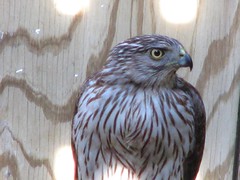
Juvenile Coop...no dark cap yet, and brown, vertical streaking (but their tails are pretty much like an adults).
Since there are plenty of juveniles beginning their lives outside the nest right now, we all will be getting lots of opportunities to divine what we are looking at.
Everyone say it with me:
"Head, belly, tail. Head, belly, tail..."

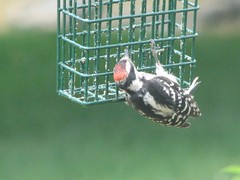

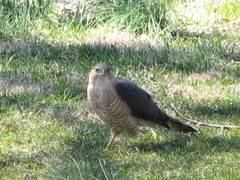
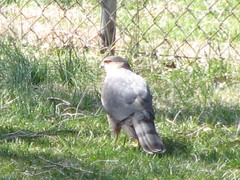
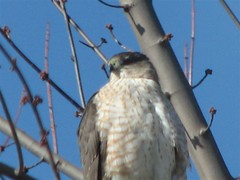
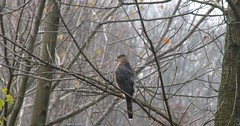
12 comments:
Head, belly, tail!
Do another one!!
Thanks for the lesson!
How about one on telling coops from sharp-shins?
;-)
Nice. HEAD BELLY TAIL! Locking that one away in my memory.
Hi Susan - I want to ditto what Laura said - I'd love to know the differences between coops and sharpies.
I'm going to be difficult.
What I see of hawks are two situations: driving by, they are sitting on lampposts or snags by the highway. I see a shape against the light, sometimes a dark or light belly, once the red shoulders of a red-shouldered hawk. That's it.
At other times, I see them across a field, hunting. And these, I can distinguish without knowing what they are. Some swoop low over the fields in bouncy figure eights. Some barely skim the grasses. Others soar high. One kind sits and looks like part of a stump.
I come home and look them up, but when I see the next one, I can't remember which flight pattern goes with which hawk.
Do you have any quick memory joggers for these characteristics?
A "good grasp on raptors"--I like that. And its true--wish you were here Monday--huge commotion in our ravine, 5 bluejays screaming at another bird (larger, hawk-like, seemed to have a golden belly)maybe had raided a nest or grabbed a juvenile?
This went on for 15-20 minutes, and the larger bird seemed to have gotten what he came for.
Kind of looked like a red-shouldered? (size and belly)
One more thing--if you're needing some time with a field guide to see if you like it,...ask your public library to get it for you. I usually start with the user comments/ratings section at Amazon, then take ISBN to library. Ohio libraries can get almost any book out there, if its not on their own shelf. Borrow it, try it, before you buy it--
What a great lesson Susan! Thanks!
Again - HEAD BELLY TAIL. I get it! I understand it! Today, but not tomorrow...or when I see another one. LOL!
Thanks, Susan for the good lesson. So you have suet and peanuts out there? No grackles or starlings terrorizing?
Head belly tail, head belly tail!
Thanks for the lesson Susan!
Hi,
what is great blog from over the ocean! greetings from berlin/germany. I am a birder and aquarist from germany.
Sadly I havent a bird blog...but you can see my guppies at
www.guppyfocus.blogspot.com
Yes, you have a very nice blog!
cheers tobi
I have a guppy with the same condition like the picture and this one is bigger and he is doing well do you think he will die on us...my email is chuco_loony@yahoo.com
Post a Comment